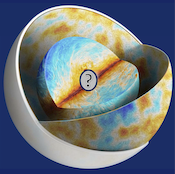Orateur
Description
In the 1990s, the COBE/FIRAS mission measured the Cosmic Microwave Background (CMB) spectrum and showed that the CMB spectral energy distribution is close to a perfect blackbody. However, the CMB spectrum contains tiny departures from a perfect blackbody to $\Delta I/I \simeq 10^{-5}$. These are referred to as spectral distortions.
The two main types of CMB spectral distortions are the Compton $y$-distortion from energy release in the optically thin regime at redshifts $z < 5 \times 10^{4}$, and chemical potential or $\mu$-distortion from the optically thick regime imprinted at $z > 5 \times 10^{4}$. Measuring those faint signals is challenging but allows us to access information about the thermal history of the Universe, from the present to the very early Universe, that cannot be extracted in any other way.
High-precision spectroscopy of the CMB is one of the three themes that have been selected by the ESA Voyage 2050 program. Several dedicated space missions such as PIXIE, PRISTINE, and FOSSIL have been proposed since 2011. Additionally, balloon-borne missions, such as BISOU, have also been considered as a pathfinder of a future space mission dedicated to CMB spectral distortions.
I will present an effort undertaken to define future missions and instruments dedicated to measuring the CMB spectral distortions. Sensitivity estimates that could be reached by such projects are calculated by combining two newly developed models. The first is a versatile photometric model based on key instrument subsystem choices together with their parameters. The second is a sky emission model taking into account spatially varying foregrounds at frequencies relevant to CMB spectral distortions.
Optimizing both instrument concept and mission parameters (scanning strategy, mission duration, ...) can be achieved by combining the outputs of those models. This would be applied here in the case of future missions dedicated to CMB spectral distortion measurement such as FOSSIL, a space mission proposed to answer the recent ESA M7 proposal, and BISOU, a CNES Phase 0 study for a balloon-borne mission.

